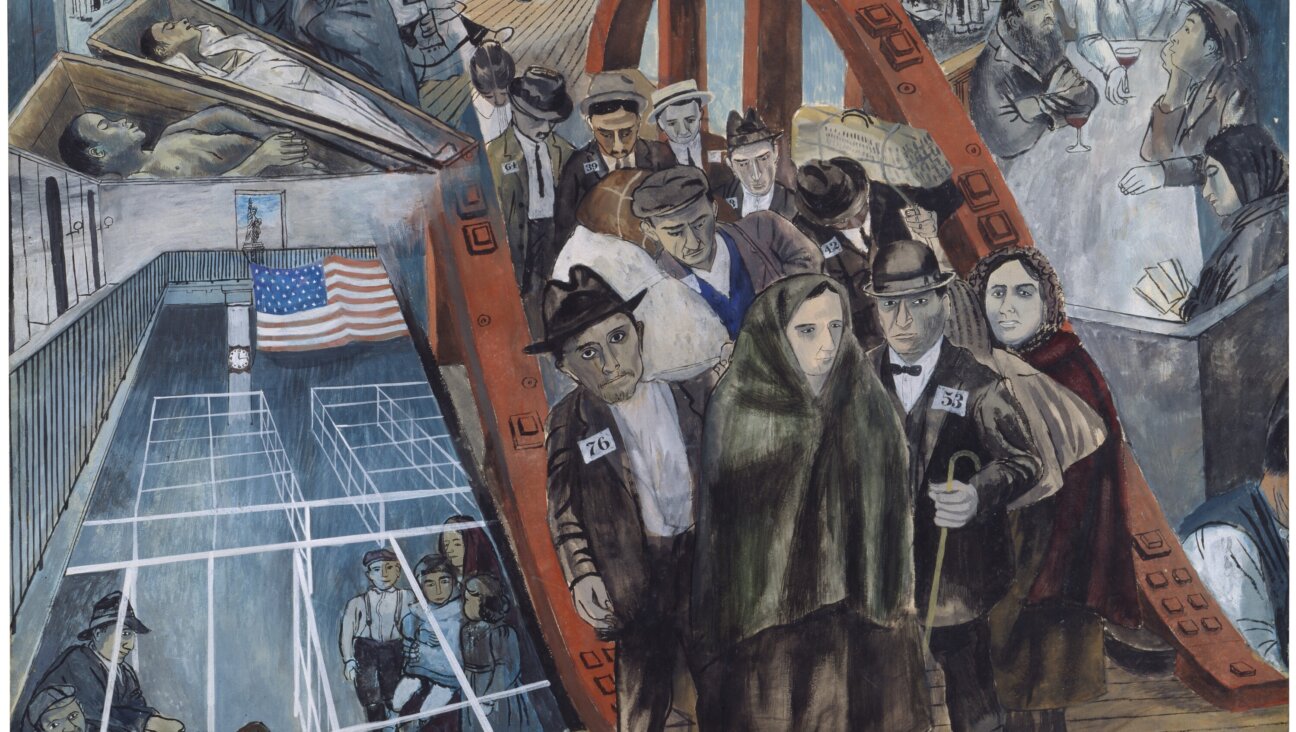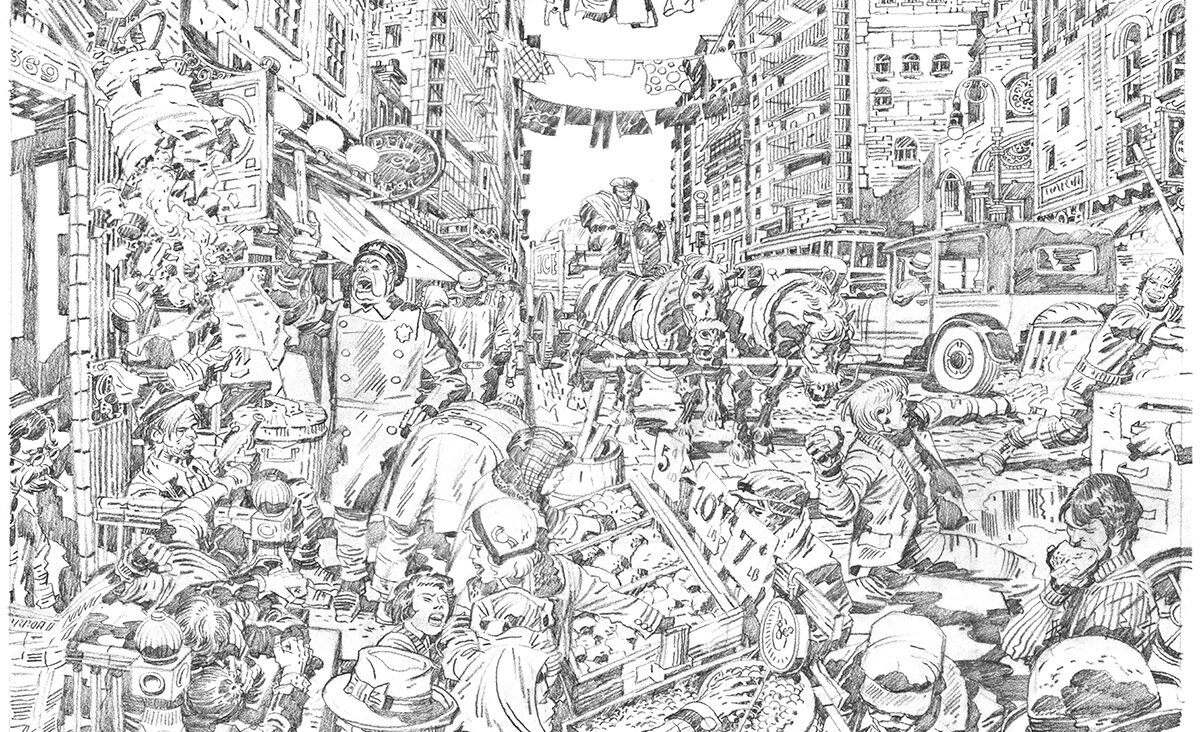Even In World’s Smallest Jerusalem, Israelis Can’t Parallel Park

Graphic by Angelie Zaslavsky
On the 50th anniversary of the reunification of Jerusalem, a massive model railroad tribute in New York City’s Times Square displays the religious, archaeological and architectural diversity of Israel’s capital – while also playfully pointing out that many Israelis still drive like schmucks.
At Gulliver’s Gate, a new Manhattan tourist attraction that officially opened on May 9, there’s an Israeli Independence Day scene in which cars are haphazardly parked on sidewalks and at all angles, without regard for designated spaces. It’s an image that captures Israeli culture as much as an overstuffed falafel pocket.
Located on West 44th Street across from the Shubert Theatre, the 50,000-square-foot exhibit bills itself as “a technologically advanced, interactive and immersive world of miniatures that will ignite your imagination and challenge your perspective.” Computer-controlled trains, planes, buses and automobiles are interspersed with world landmarks. Visitors can control elements of the interactive displays with an ornate souvenir key that serves as their admission ticket, and many countries go through a day-and-night cycle with timed lighting effects.
The Jerusalem section of Gulliver’s Gate contains many landmarks — the Western Wall, the Knesset, the Shrine Of The Book, Mahane Yehuda Market, etc. — but also places and things not widely known to tourists. Perhaps most immediately noticeable is the giant black-and-white monster with freaky eyes. Known as “HaMifletzet” in Hebrew, the beast’s three tongues are slides and have long been a childhood rite-of-passage in the city’s Kiryat HaYovel neighborhood.
“Anybody who has lived in Jerusalem, if they had kids, knows that monster,” said Gulliver’s Gate’s CEO, Eiran Gazit. “When I emailed a picture of it to my boys, the way they reacted, I could hear their smiles.”
For the Israeli-American entrepreneur Gazit, a ninth-generation Sabra, Gulliver’s Gate is his second foray into shrinking the world. In 2002 he founded Mini Israel, which gathered all of Israel’s major landmarks into one park at 1:25 scale (more than three times bigger than Gulliver’s 1:87 models). Located near the Latrun Armored Corps Museum halfway between Tel Aviv and Jerusalem, the attraction is still open, but Gazit sold his share years ago. The park is outside, requiring the buildings and figurines to use automobile paint resilient to the sun and weather.
Yoni Shapira, Gazit’s former partner at Mini Israel, was also the project manager for Gulliver’s Jerusalem. “Building Mini Israel was a much longer process,” he recalled. “It was built at a time when most work was by hand and needed artistic and model-making expertise. For Jerusalem at Gulliver’s Gate, we needed technical experts in 3-D rendering, printing and assembly, and needed the artistic eye and hand only for the finishing touches.”
The modeling team used original blueprints of buildings whenever possible – even getting permission from Jerusalem’s Greek Orthodox Patriarch to use the plans for the Church Of The Holy Sepulchre – and relied on hundreds of photos of buildings from every angle to ensure accuracy.
Another carryover from Mini Israel was keeping politics out of model railroading as much as possible. At his first park, Gazit avoided miniaturizing sites that were controversial, such as West Bank settlements, inevitably opening himself up to some criticism from the right. This time, the only political tension that surfaced in Mini Jerusalem was between meat eaters and vegans. A group of anti-meat protesters are shown picketing in front of the Knesset. “I didn’t want to show any political demonstrations in which I would have to choose sides,” Shapira explained. “My daughter, Yael, and one of the model makers are both vegan, so we gave them a say. It’s an issue that is discussed in the public sphere in Israel, so why not? I’m a carnivore, by the way.”
Avoiding politics counters the brazen approach of Germany’s Miniatur Wunderland, the self-proclaimed “largest model train exhibition in the world” and one of Gazit’s inspirations. The attraction, which draws more than 1 million visitors a year, recently took a jab at Donald Trump by building a temporary mini-wall around its mini-United States. The German attraction also has a more risqué sense of humor, including scenes of a strip club and teenage sex in a bouncing van, in its promotional video.
In contrast, all the humor is rated G at Gulliver’s Gate. The Loch Ness Monster pops up in Scotland, a mummy chases a tourist in Egypt, tourists try to correct the angle of the Leaning Tower Of Pisa with a rope, and a lion scares a stray cat at the Roman Colosseum.
Remote-controlled cameras and video screens allow visitors to zoom in on details they may otherwise miss with the naked eye. At 1/87th his normal size, for example, the 6-foot-8-inch LeBron James would stand at just 9/10ths of an inch. Visitors can also visit a control room made to look like the North American Aerospace Defense Command, where technicians watch a wall of screens to monitor traffic patterns and prevent or fix vehicle malfunctions.
“I think visitors of all ages will be wondering. ‘How did they do that?’ Which is why we are giving a lot of access to our model makers and our tech teams,” Gazit said. “People can interact with the people who actually create and make these things. I’m not a psychologist, but there has to be a psychological reason why people are fascinated by miniatures in the same way that they’re in awe about big things.”
For Michael Langer, co-founder and vice president of development, there’s a nostalgic lure to Gulliver’s Gate that goes back to his childhood building models with rubber cement.
“I was unfortunately born with all thumbs,” he said. “There were plenty of tables and carpets I ruined from paint that I didn’t manage to get on the models. Fortunately, I’m now working with a talented team who can build these amazing displays.”
“When I was 9, my dad took a year sabbatical and our family moved to Jerusalem. One of the cool things was that we could see the Israel Museum and what I used to call the vanilla Hershey Kiss,” Langer added, referring to the domed Shrine Of The Book. “So I feel a very personal connection to this model. Some people might find this odd, but I also love the gas station at the entrance to Jerusalem. It’s bright, it’s yellow and it always greets me when I enter or leave the city. The fact that it’s at Gulliver’s Gate makes me smile.”
To anyone as intimately familiar with the Jerusalem landscape, seeing the model of a stone-and-glass pyramid skyscraper might raise some eyebrows. The building, designed by celebrated architect Daniel Libeskind, doesn’t exist yet and might not ever be built. The Eden Tower, proposed for the site of the former Eden Cinema near Mahane Yehuda, was originally slated for 165 meters (541 feet) – about half the size of the Eiffel Tower – then cut down to 118 meters (387 feet) by city officials in 2015. The project, also called the “Freedom Pyramid,” is supposed to break ground in 2019, but it faces public opposition for how it would impact the skyline.
“We wanted to show Jerusalem’s balance between its modern architecture with its ancient architecture,” Gazit explained, “Also, if you look to the left of Libeskind’s tower, you’ll see the pyramids of Egypt, and if you then turn around, you’ll see the Aztec and Incan pyramids in Latin America. And suddenly, you realize that the pyramid shape has been with us for thousands of years and exists across many cultures. We’re all connected.”
As Times Square is a constantly overflowing mix of cultures and languages, Gazit will soon find out if tourists around the world (and New Yorkers) will enjoy gawking at themselves and each other in miniature. As for the teeny-weeny “model citizens,” they all share a common existential problem – regardless of their corresponding geopolitical realities outside Gulliver’s Gate.
“Our biggest enemy is dust,” Gazit lamented. “We have some strategically placed vacuum systems hidden under the models, and we have a team of specially trained modelists who will clean every night. But there will also be some cleaning done while visitors are here, because they like seeing that – it will be part of the show.”
Gulliver’s Gate is located at 216 West 44th Street, New York, New York. For more information, visit GulliversGate.com.
Darren Garnick is a freelance writer and documentary filmmaker based in New Hampshire. He writes about politics, travel and pop culture at darrengarnick.com





















